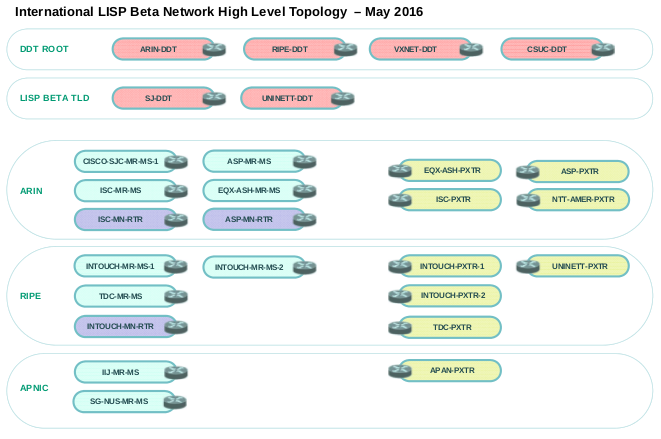LISP Host Mobility Demo – VMworld 2012 Barcelona
There’s a really nice (short) LISP Host Mobility Demo posted on YouTube from VMworld 2012 Barcelona. Check it out!
Cisco Live London LISP Sessions!
The Cisco LISP Team is preparing to deliver an UPDATED Advanced LISP Tectorial at Cisco Live London (January 2013)
(TECIPM-3191 – Advanced – LISP Techtorial)
This is a full day immersion into the different aspects of LISP. We’ll be covering not only the details of LISP for the various use-cases, but also some of the details of real, production, customer deployments. Use cases include VM-mobility, Internet Multi-homing, Large Scale WAN VPNs, Multi-tenant VPNs, Mobile Node mobility.
We will also be hosting an updated Walk In Self Paced (WISP) Lab on LISP. This Lab includes modules that cover multihoming, IPv6 transition, LISP/non-LISP interworking (PxTR deployments), and Shared Model Virtualization
We hope to see everyone at Cisco Live London!
http://www.ciscolive.com/london/registration-packages/
LISPmob adds IPv6 EID support
The LISPmob Project, which was previously featured in our news section, has recently released version 0.2.0 of the software. The major new feature in this release is support for IPv6 EIDs, but a lot of important bug fixes are included as well.
See the full announcement in the LISPmob mailing list archives.
A Linux Implementation of LISP Mobile Node Announced
A new open source project called LISPmob announced a Linux implementation of the LISP Mobile Node specification. The source code is available both as a tarball from the project home page, or as a git repository from Github.
The full announcement is available from the LISPmob mailing lists archives.
LISP support in mainline Wireshark
The Wireshark community released a new stable branch of their popular packet analyzer with the 1.6.0 version. A noteworthy addition for the LISP community in this release is support for decoding LISP data and control packets, based on the patch from UPC previously mentioned here. The full release notes are available on the Wireshark project page.
The latest features, such as experimental InstanceID support, are still being released on the UPC project page first. Alternatively, the the github repository of the patch can also be watched for bleeding edge code.
New Cisco IOS and IOS XE Images for LISP Now Available
Cisco recently announced that LISP has now been integrated into the Mainline IOS and IOS XE releases. In addition, a new Engineering Special for IOS was also released.
- LISP has now been included in MAINLINE Releases for IOS and IOS XE. The IOS image is the 15.1.4M release, and the IOS XE image is the 3.3.0S release. These images are FULLY supported by Cisco for any deployment scenario, including LISP. (The LISP code included in these mainline IOS and IOS XE images does not support LISP virtualization, however. LISP virtualization is only supported in the engineering images, but will be included in the next Mainline release.)
- A new LISP Engineering Special Release for IOS is now available. The IOS image is the 15.1(4)XB4. This LISP Engineering Special Release for IOS is also fully supported by Cisco for LISP deployments scenarios. This new LISP Engineering Special Release includes full support for LISP virtualization, and includes support
for the “ALT-less” deployment of a LISP PITR.
For details on these new releases, to download software, and to find other information about Cisco implementations of LISP please visit: http://lisp.cisco.com
Furukawa Network Solution Corporation (FNSC) Deploys LISP Router
Our colleagues at KDDI Labs, in partnership w/ Furukawa Network Solution Corporation (FNSC) have successfully deployed LISP on an FNSC router. The FITELnet G21 router is currently operating in the LISP Beta Network. Near-term plans include further LISP interoperability testing, and multi-homing testing.
For interest, information on FNSC and their router is here:
- FNSC http://www.fnsc.co.jp/ (Japanese only)
- FITELnet-G21 http://www.furukawa.co.jp/fitelnet/product/g20_21/index.html (Japanese only)
Welcome to LISP!!
LISP MIB Internet-Draft has been adopted by the IETF WG
This Internet-Draft defines managed objects for the Locator/ID Separation Protocol (LISP). These objects provide information useful for monitoring LISP devices, including basic configuration information, LISP status, and operational statistics.
The draft is available here: ietf-lisp-mib-00.txt
Wireshark patch updated for new control packet format
The previously mentioned packet dissector patch was updated to support the new control packet format introduced in the -07 revision of the main LISP specification draft. Other changes:
- Map-Request flags are now decoded
- Mapping records have their sub-tree with details, highlighting individual fields
LISP packet decoding support added to Wireshark
It is now possible to use the popular open source packet analyzer Wireshark to dissect both LISP control packets and the LISP header of encapsulated data packets. A patch is available from the LISP team at UPC/BarcelonaTECH against the 1.2.x stable Wireshark branch.


